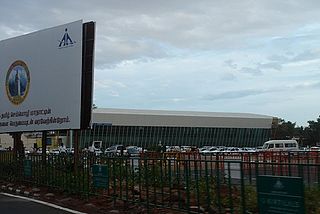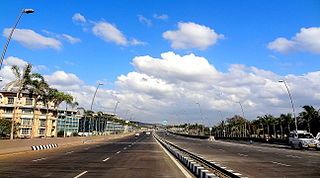Transport in India consists of transport by land, water and air. Public transport is the primary mode of road transport for most of the Indian citizens, and India's public transport systems are among the most heavily used in the world.

Bus rapid transit (BRT), also called a busway or transitway, is a bus-based public transport system designed to improve capacity and reliability relative to a conventional bus system. Typically, a BRT system includes roadways that are dedicated to buses, and gives priority to buses at intersections where buses may interact with other traffic; alongside design features to reduce delays caused by passengers boarding or leaving buses, or purchasing fares. BRT aims to combine the capacity and speed of a metro with the flexibility, lower cost and simplicity of a bus system.
The Northwest Corridor Express Lanes and locally known as the Tollercoaster, is a completed Georgia Department of Transportation (GDOT) project which has put Peach Pass-only toll lanes along Interstate 75 (I-75) and I-575 in the northwestern suburbs of the Atlanta metropolitan area. It carries traffic between northwest Atlanta and Cobb and Cherokee counties by adding two lanes for paying vehicles along I-75, with one continuing up a dedicated exit onto I-575 to Sixes Road, and the other straight on I-75 to Hickory Grove Road, just past Wade Green Road. North of the interchange where they split, the new lanes are located in the median, between the original northbound and southbound lanes. From the Perimeter to I-575, the road had already been built with 12 to 16 lanes, which required other plans, including via eminent domain.

The Emerald Express (EmX) is a bus rapid transit (BRT) system in the Eugene-Springfield metropolitan area in Oregon, United States. It is provided by the Lane Transit District (LTD) which is the public transit authority in Lane County, Oregon.

The Mississauga Transitway is a bus rapid transit (BRT) system in Mississauga, Ontario, Canada. It comprises a series of purpose-constructed bus-only roadways, as well as reserved lanes on existing city streets and portions of Highway 403, that together form a continuous 18 km (11 mi) route spanning most of the city from Winston Churchill Boulevard in the west to the junction of Highways 401 and 427 in the east on the border with Toronto. Service on the Transitway is provided by MiWay and GO Transit, with some stations providing connections to Brampton Transit and Toronto Transit Commission bus services.

Janmarg, also known as Ahmedabad BRTS, is a bus rapid transit system in Ahmedabad, Gujarat, India. It is operated by Ahmedabad Janmarg Limited, a subsidiary of Ahmedabad Municipal Corporation and others. It is designed by CEPT University. It was inaugurated in October 2009. The network expanded to 89 kilometres (55 mi) by December 2017 with daily ridership of 3,49,000 passengers. BRTS won several nation and international awards for design, implementation and operation. It was rated Silver on BRT Standard in 2013.
Bangalore BRTS was a proposed bus rapid transit system in Bangalore, Karnataka. Beginning with a comprehensive report in 2007, and even earlier, several proposals were made to implement a BRTS in Bangalore.
The Delhi BRTS was a bus rapid transit system in Delhi. The first route opened in 2008 ahead of the 2010 Commonwealth Games, which were held in the city. The project was well used but has been criticised for the difficulty of access to the bus platforms, which are in the middle of the road, for lack of enforcement and for the effect it has had on other motor traffic. A legal challenge was defeated in 2012. The Aam Aadmi Party Government had announced the scrapping of bus rapid transit system and it was dismantled in 2016, because of traffic congestion and accidents.
The Eastern Freeway is a controlled-access highway, in Mumbai, that connects P D'Mello Road in South Mumbai to the Eastern Express Highway (EEH) at Chembur. It is 16.8 km long and its estimated cost is ₹1,436 crore (US$200 million). The Eastern Freeway was built by the Mumbai Metropolitan Region Development Authority (MMRDA) and funded by the Central Government through the Jawaharlal Nehru National Urban Renewal Mission (JnNURM). Construction was contracted to Simplex Infrastructure Ltd. A 13.59 km stretch of the freeway, comprising two of three segments with one of the twin tunnels, from Orange Gate on P D'Mello Road up to Panjarpol, near RK Studios in Chembur, was opened to the public on 14 June 2013. The second tunnel was opened on 12 April 2014. The third and final segment from Panjarpol to Ghatkopar-Mankhurd Link Road (GMLR) was opened on 16 June 2014.

The first bus rapid transit in Brazil (BRT) was built in 1974 in the city of Curitiba by the then mayor, architect Jaime Lerner, and became the second BRT in the world. The goal of the system is to provide high quality rail transit service to customers and at a comparable cost to that of a bus transit. Curitiba's success inspired the implementation of similar plans in more than 100 cities around the world, including the Brazilian cities of São Paulo, Rio de Janeiro, Belo Horizonte, Porto Alegre, Manaus, Goiânia, Aracaju, Salvador, Recife, and Brasília.
Jeejabai Bhosle Marg, the official name of the Ghatkopar-Mankhurd Link Road (GMLR) or the Mankhurd-Ghatkopar Link Road (MGLR), is a road in eastern Mumbai connecting the suburbs of Mankhurd and Ghatkopar. It connects to the Mumbai Pune Expressway via the Sion Panvel Highway. The road is 4 km long and 200 feet wide. Construction on its main carriageway started in 2005 and it was opened in 2007.

Coimbatore has a well-developed transport infrastructure. The city and its suburbs is traversed using its road networks. Coimbatore is well connected by Road, Rail and Air with most cities and towns in India except through waterways. The city has fairly better transport infrastructure, though road infrastructures are not well maintained and developed according to the growing needs of transport, making traffic congestion a major problem in the city. A comprehensive transport development plan is made part of Coimbatore Masterplan as part to ease many of traffic problems.

Bus rapid transit in New Jersey comprises limited-stop bus service, exclusive bus lanes (XBL) and bus bypass shoulders (BBS). Under the banner Next Generation Bus New Jersey Transit (NJT), the New Jersey Department of Transportation (NJDOT), and the metropolitan planning organizations of New Jersey (MPO) which recommend and authorize transportation projects are undertaking the creation of several additional bus rapid transit systems (BRT) in the state. In 2011, NJT announced that it would equip its entire bus fleet with devices for real-time locating, thus creating the basis for "next bus" scheduling information at bus shelters. The introduction and expanded use of bus rapid transit in Garden State is part of worldwide phenomenon to bring mass transit to heavily trafficked corridors in both high and medium density areas as a cost-saving, and sometimes more flexible, alternative to rail transportation, thus reducing automobile dependency and traffic congestion.

The Sahar Elevated Access Road, abbreviated to SEAR, is a dedicated, elevated, express access road in Mumbai that connects the Western Express Highway (WEH) near Hanuman Nagar junction in Vile Parle, with the forecourts of Terminal T2 of the Chhatrapati Shivaji International Airport. The road improves access and travel times between the WEH and the airport. The 2.2 km long access road has 4 entry and 2 exit points. The road also includes an underpass for vehicles travelling on the WEH and a pedestrian subway; as well as an underpass, a tunnel, and ramps connecting the highway to the terminal which bypasses the congested roadways below.
BRT creep is a phenomenon commonly defined as a bus rapid transit (BRT) system that fails to meet the requirements to be considered "true BRT". These systems are often marketed as a fully realized bus rapid transit system, but end up being described as more of an improvement to regular bus service by proponents of the "BRT creep" term. Notably, the ITDP published several guidelines in an attempt to define what constitutes the term of "true BRT", known as the BRT Standard, in an attempt to avert this phenomenon.
Pune is a city in the state of Maharashtra in India.It is situated in western Maharashtra on the Deccan Plateau,the roads in Pune are slopping and windy which were built on the natural slopes of the terrain. Pune's public transport consists primarily of a bus service, a suburban rail service, public taxis and auto rickshaws. A metro is under construction as of 2019.

Amritsar MetroBus is the bus rapid transit system (BRTS) in the city of Amritsar, Punjab, India. Amritsar MetroBus allows easy travel to different places in city like the Golden Temple, Jallianwala Bagh, Guru Nanak Dev University and Khalsa College for nominal fares. The time gap or frequency between two buses on the same route is five minutes.

Rainbow BRTS is a bus rapid transit system in the city of Pune. The system is operated by the Pune Mahanagar Parivahan Mahamandal Limited (PMPML). The infrastructure has been developed by the Pune Municipal Corporation & Pimpri Chinchwad Municipal Corporation, Pune. The project currently envisages 113 km of dedicated bus corridors along with buses, bus stations, terminals and intelligent transit management system.
TransPeshawar or Peshawar Bus Rapid Transit is a bus rapid transit system in Peshawar, capital of Pakistan's Khyber Pakhtunkhwa (KP) province. TransPeshawar BRT system consists of two parts: the first encompasses an east-west corridor served by 32 stations on a dedicated lane for exclusive use by buses, while the second part consists of a network of feeder routes in which buses can enter and exit the system to travel on city streets. The system was inaugurated on August 13, 2020, and is the fourth BRT system in Pakistan.










